Editor’s Note: Distance learning technologies make learning accessible to larger numbers of students, especially those who are time bound (cannot fit class schedules) and space bound (distant from campus). Materials produced for distance learners often enhance learning for on-campus students and raise the overall quality of teaching and learning. This is an example from an Open University in India.
Virtual Classroom Modules for Basic Electronics Course at YCMOU: An Overview
Chetana H Kamlaskar
India
Abstract
Since 1996, Yashwantrao Chavan Maharashtra Open University, Nashik, has offered a technical academic programme ‘Electronics Engineering Diploma Programmes (EEDP)’. Heterogeneity of learners and non-uniform delivery of course content at each study centre creates a series of problems in delivering technical education. The University has attempted to keep up with curfrent distance learning technologies for imparting quality learning anywhere, anytime.
To retain the student interest in the learning process and make learning more enjoyable and exciting, highly interactive Virtual Classroom Modules (multimedia learning materials) have been created that incorporate text, video, audio and graphics with simple interactive animation. VCMs combine distance education instructional pedagogy with the latest interactive multimedia technology.
The work described in this paper represents an innovative approach to the design; creation, use and total quality assurance of VCMs for the ‘Basic Electronics-2’ theory course. It describes how VCMs enhance traditional teaching methods and help the learner to conceptualize principles of electronics and understand dynamic behavior of the electronics circuits.
Introduction
In 1996, the Yashwantrao Chavan Maharashtra Open University (YCMOU) introduced a technical programme, Electronic Engineering Diploma Programme (EEDP), for the first time in India. This program provides an opportunity for disadvantaged sections of society to pursue higher education in electronic engineering. These persons could not attend traditional on-campus programs for various reasons. All EEDP courses were designed specifically to enhance and refine the skills needed in today's rapidly changing competitive world of technology.
Across the state of Maharashtra, approximately 200 counselors enroll 5000 learners (students) at 40 different study centres annually. These students are from diverse academic backgrounds, interests, and motivation.
To a large extent, the success of any programme, depends upon the quality of its learning materials, delivery systems and evaluation mechanisms. Open and distance education is now established strongly in India. Until now there has been a heavy emphasis on print media for learning materials and little use of audio, video, TV, CD, etc.
In distance education, it is assumed that learners are self motivated and capable of learning on their own. Not all the learners have reached this level of maturity when they enroll in distance education programme for the first time. Thus, various media must be incorporated to enhance their learning process.
The university supports print materials with Virtual Classroom Modules (VCMs) to improve both effectiveness and efficiency of the self-learning process for the EEDP students. The development objective is to create interactive materials that combine graphics, animations, audio/video and text in an exciting environment that provide in depth exploration of the electronics concepts and allows the learners to understand the dynamic behavior of electronics circuits and how these circuits can be utilized in real life situations.
What is Virtual Classroom Module?
Virtual Classroom Modules are ‘well prepared high quality multimedia lectures from the master trainer, which are followed by discussion and/or tutorial during face to face counseling sessions at each study centre’. One of the most important purposes of development of a Virtual Classroom Module (VCM) is to increase student understanding. Other important purpose is to increase student, interest, motivation, and retention and to provide uniformity in counseling.
Interactive multimedia delivery systems greatly enhance the teaching-learning process in a higher education setting. It is well known from educational studies that we remember about 20% of what we hear, 40% of what we see and hear, and about 75% of what we see, hear and do. In addition, CBI programs provide a 10 to 20% of learning improvement as compared to conventional classroom teaching (Molnar, 1990, cited in Oblinger, 1992, p. 6).
Numerous educational studies show that the majority of students are visual learner. The information conveyed to students through interactive multimedia learning materials helps to enhance their performance by stimulating multiple senses. Further, the students of today require a more stimulating approach to learning. A step-by-step animation of a circuit ,with explanations, will make a lasting impression on students and make it easier to recall. VCM uses the multiple-sense approach to learning to increase retention in order to foster interest in the material necessary for retention. (Karuppan, 1999).
Heterogeneity of learners as well as non-uniform delivery of course content at each study centre creates a very serious problem in imparting technical education. During each counseling session, student learning depends on the presentation method/style of the instructor. While some instructors may express themselves fluently, others are less articulate even though they know their subject well. Further, to make the learning process more enjoyable and exciting, highly interactive VCMs have been created that incorporate text, video, audio, graphics, simple and interactive animation. "The best use of technology occurs when the academic complements a deep understanding of the subject with imagination and a vision of how the subject could be taught differently with new technologies" (Bates, 2000, p.75). Thus the use of standardized counseling aids like VCMs makes the presentations more uniform.
Multimedia applications spark interest and enthusiasm for learning. A VCM may be used before starting a new topic to give an overview, stimulate a student’s attention, and prepare the student before starting actual discussion. This approach to present fundamental concepts for critical discussion and understanding is the most effective because each presentation module is followed by discussion and/or tutorial for about 15 ± 5 minutes with a counselor. It ensures effective learning and active participation of students and fully engages the student in the learning process. Furthermore, it encourages higher level of thinking and allows students to develop skills in dealing with the technology in a professional environment.
Mixing both face-to-face counseling and VCMs provide an engaging environment for an optimum learning experience. VCMs are more effective than self-instructional textbooks because of their audio-visual media and interactive components. The University plans to develop VCMs which combines distance education instructional pedagogy with latest interactive multimedia technology for imparting quality learning anywhere, anytime.
New Perspective of Teaching
One of the most essential factors in a student's academic success is his/her desire to learn. This desire can be enhanced by presenting course material in an attractive manner that motivates students to learn. For example, combining text, audio, graphics, and motion to animate technical concepts/circuit diagram helps students to understand the main concepts and enable “learning by doing”. VCMs have proven to be effective in technical education because they hold students' attention and encourage their involvement.
To create a learning environment in web compatible electronic form, the course contents of BET042: Basic electronics-2, Theory were divided into small topics known as modules. Duration of a typical VCM is limited to 20 ± 5 minutes to ensure student’s concentration. For each credit point, the University plans to develop 5 VCMs. Hence, for this 6 credit course point, a total 30 VCMs were developed. This covers most of the difficult topics like operational amplifier, oscillators and power supplies and their applications. To understand and explore each electronic circuit and its analysis in depth, appropriate media is to used. For example, to illustrate operation and analysis of various Op Amp circuits, 20 modules are available on Op Amp. During the VCM presentation, various effects such as ‘Entrance, Emphasis, Exit and Motion’ are used to highlight important concepts, key points and steps in circuit operation Synchronized audio improves learning effectiveness and retains student interest during presentation. At the end of each module, there are summary, solved examples, data sheets, study tips, and on-line self-tests.
VCMs can be used in two modes - standard mode and slide show mode. Standard mode is recommended to reinforce self-study. It provides better flexibility and controls for the individual learner. In this mode learner needs to interact with VCM to continue its play, which ensures more learner involvement in the learning process. Use of slide show mode is recommended at the study centre to provide better visibility and unattended play of sound and animation for all VCM slides.
Development Process of VCM
‘In open and distance education, the expected outcomes of learning depend heavily on efficient and effective design of instructional materials to fit peculiar characteristics and needs of the adult learner (Jegede, 1992, 1998). The teaching of course content must also be done using appropriately selected media or technology to complement or supplement the print based materials. All these complex and inter-woven activities in the delivery of instruction at a distance aggregate to form enormous tasks which require extensive research effort to generate information which support and guide the accomplishment of the tasks’.
Olugbemiro Jegede
Centre for Research in Distance & Adult Learning
Open University of Hong Kong
Dr. A P J Kalam, President of India expressed this need clearly while addressing the inauguration of the conference on EDUSAT, Bangalore (23-07-2004: Bangalore):
‘There are three components for education: lectures, laboratory and library. The content includes all the above three. The content should have supportive animations, which may even bring virtual laboratories and virtual immersion effects to the remote students. When the content is generated, it should be a sharable learning object across the nation and across all platforms. The content may be generated making use of the student’s creative and innovative thoughts under the guidance of the expert teachers as a group activity based on a pre-determined standard.’
Thus, the development process is based on research and best practices. This paper sets out the processes and procedures dev eloped by the School of Science and Technology, YCMOU to successfully implement design and creation of highly engaging and accessible learning materials. VCM development is teamwork involving many steps and processes. A brief summary of the VCM development process (Killedar, 2002) is as follows:
1. Prepare a list of probable VCM Titles for difficult topics from the course
2. Identify experts for the development team and allot work to them
3. Prepare the first draft of VCM: Storyboard for each slide and transcript of associated text or lecture (prepared by Academic Resource Person)
4. Edit Content and Technical Skills (Academic and Technical Editor)
5. Edit Language (Language Editor)
6. Modify first draft of VCM: incorporate suggestions of editors for each slide and transcript of its associated lecture/presentation (Academic Resource Person)
7. Prepare Second draft of VCM in an electronic form (Technical Resource Person)
8. Obtain collective approval from (1) Academic Resource Person (2) Academic and Technical Editor and (3) Language Editor
9. Prepare and submit Third draft of VCM in electronic form, containing prerecorded lecture for each slide and basic animation by Technical Resource Person
10. Assess ‘Total Quality’ for final approval or rejection by ‘School Preview’
11. Update final draft to final VCM for Committee approval
12. Pay Honorarium to all members of development team (by University).
VCM Templates
Based on distance educational pedagogy and interactive multimedia technology, a VCM template was developed to guide new developers. Templates have a number of advantages that include:
§ Ease of use
§ Uniformity
§ Cost-effectiveness
§ A number of evaluative strategies to ensure quality
§ Clear delivery methods (e.g. DVD, CD-ROM/ WWW)
Table 1 shows the details of VCM templates
Table 1
VCM Template
Sr. No. | Name of Slides |
1 | VCM-CCCXXX-XXX : Module Title |
2 | Credits |
3 | Learning Objectives Each module has well defined learning objectives. |
4 | Prerequisites Each module has clearly stated pre-requisites for the fruition |
4 | Introduction, where the main goal of the module is stated and curiosity is aroused to learn the module content. |
5 | Key Terms: This consists of a list of important terms which student should know and are frequently coming across the modules. |
6 | Section Title of Your Module-1: which is the real body of the module content, containing the explanation of all the concepts, circuit operations, procedures etc; |
7 | Section Title of Your Module-2: which is the real body of the module content, containing the explanation of all the concepts, circuit operations, procedures etc; |
8 | Section Title of Your Module-3 : which is the real body of the module content, containing the explanation of all the concepts, circuit operations, procedures etc; |
9 | Section Title of Your Module-4: which is the real body of the module content, containing the explanation of all the concepts, circuit operations, procedures etc; |
10 | Section Title of Your Module-5: which is the real body of the module content, containing the explanation of all the concepts, circuit operations, procedures etc; |
11 | Section Title of Your Module-6: which is the real body of the module content, containing the explanation of all the concepts, circuit operations, procedures etc; |
12 | Summary, which consists of a list of the fundamental concepts the student should have acquired after studying the main content; |
13 | Study Tips (Includes book references, links to datasheets, website address related to content covered, Online Self Test) A link to online self-test provides self-evaluation in the form of a test with automatic feed-back; it consists in a set of questions with predefined answers, and the result obtained may be used to determine whether or not the student has acquired the required exit level of knowledge for the module. |
14 | End of the Module |
15 | Solved Examples (To refer required formulae, hyperlinks are provided to particular content) which contains a collection of exercises with their solutions so that the student can check the knowledge of the concepts presented; |
16 | Derivation (To refer how formulae/equations are derived, hyperlinks are provided to particular content) which contains a collection of steps so that the student can check how the particular formula is derived based on knowledge of the concepts presented. |
Coherence and Integration of Media and Technology in VCM
Standardized software and hardware are used to create each stand-alone, self learning (user friendly) module.
§ Web compatible technologies
§ State of art of compression techniques to keep small file size
§ Simple animation to explain difficult concept and circuit operation
§ Synchronization of animation with timeline of audio lecture
VCMs are designed using only web compatible technologies to facilitate distribution on the web and/or CD. Small file size and rich multimedia quality is ensured by using state of art software and compression techniques. Without video, a typical VCM size is approximately 3 MB. Hence, about 200 VCMs can be easily accommodated on a single CD. To distribute 30 VCMs of BET042 course one CD is sufficient. The cost of CD is negligible compared to printed textbooks, so students can get a multimedia learning experience at low cost.
VCMs are the best viewed with Microsoft’s ‘Internet Explorer 6’, ‘Office Animation Runtime’, ‘Windows Media Player 9’ and ‘Adobe Acrobat Reader 6’ at a minimum 800 x 600 resolution and true color setting on any multimedia PC. This free software can be downloaded from web.
Using this standardization, students are able to interact with real teachers through discussion forum on web for online counseling. Online self-tests on the University website enables the students to receive formative feedback about the content covered in the module.
Quality Assurance
Total quality testing is an integral part of the development process in development of high quality VCM learning materials. Rigorous testing is undertaken by the School preview committee. The developed VCM material is subjected to rigorous quality controls to ensure the materials are of high quality, meet all guidelines, and are fit for purpose. Figure 1 shows various qualities Controls.
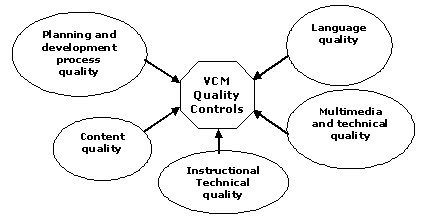
Figure 1. The University constituted a School Preview Committee
to evaluate the total quality of each VCM as a learning tool.
A quality parameter checklist based on developed based on the above quality parameters, cover:
§ Content
§ Functionality
§ Cross-compatibility
§ Compliance to YCMOU guidelines
§ Web compliance for people with disabilities
The School Preview Committee evaluates Total Quality of the VCM. Each quality parameter is assessed on a 5 point scale by consensus among the members. A minimum 300 quality points is essential for acceptance; otherwise VCM is rejected. Suggestions for quality improvement from the “School Preview Committee” are incorporated in the final version of VCM.
Evaluation
To determine the impact of VCMs on the students learning and to improve teaching of the course, students were interviewed and quality of the prepared modules was evaluated by evaluating following quality parameters:
§ Planning and Development Quality
§ Content Quality
§ Instructional Technology Quality
§ Language Quality
§ Multimedia Quality
A ‘Total Quality’ Assessment Format was used to take students opinion about total quality consisting of content quality, language quality, and instructional technology quality of all these modules. Students were also interviewed related to accessibility, effectiveness of modules, its help in clarifying difficult concepts, and organization of modules. Since, the modules were available on the web; comments were received from students and faculty from other universities. Students were excited and satisfied by this new learning tool compared to traditional style of teaching. They also stated that the VCMs aided in conceptualization of Electronics principles and circuit operations that could be effectively applied in practice. The initial experience of students as well as faculty has been very positive.
Evidence of Impacts
Technology in and of itself does nothing to improve education. The use of technology as a tool, the use of technology to supplement learning, and the use of technology to draw the students in and create the stimulating environment that fosters learning is what is needed.
Almost all students preferred modules that incorporated animation and interactivity to traditional static images and diagrams. They welcomed the technology with enthusiasm and overwhelmingly considered that these VCMs to be helpful in understanding difficult concepts. Hence, students will learn more and retain more as VCMs are developed with ‘Self-Instructional’ features of distance education pedagogy.
In addition, they are able to gain access at their own time and pace outside the classroom and laboratory as VCMs are available for use on Web and/or CD. With VCMs the student’s ability to analyze, think and apply various electronics concepts are enhanced. Students are encouraged to engage in creativity, design processes, and troubleshooting electromechanical systems that they use at home and work place.
Examples of VCMs Topics
Basic Theory of Differential amplifier: Two modules are available on differential amplifier which allows students to study different configuration of differential amplifier, its basic principle of operation, why differential amplifier is used as a building block of IC Op Amp. For better understanding of analysis of differential amplifier, circuit animation in streamline with audio is done. Thus, the students understanding of the underlying concepts have been enhanced by providing a rich suite of circuit’s animation.
Op Amp Theory: Modules available on this topic, gives the students the ability to immediately familiarize with the various terminologies used in Op amp, its ideal and practical characteristics, circuit symbol and its pin diagram. In addition student can investigate the basics associated with the characteristics, DC biasing, open loop and closed loop configuration of Op Amp with the help of various Op Amp circuit via a combination of simple animation and audio.
Inverting Op Amp Amplifier: Closed loop configuration of Op Amp in inverting mode has been used as the foundation for this module. This module gives the student the ability to immediately study the effect of negative feedback on the amplifier gain, input impedance, output impedance, offset voltage and frequency response. With the aid of a highly animated circuit diagram, the virtual ground concept and analysis of Inverting amplifier using virtual ground concept has been illustrated.
Noninverting amplifier using Op Amp: This module provides the student with an understanding of how noninverting amplifier can be designed and analyzed using Op Amp which will meet most of the ideal characteristics of voltage amplifier. More emphasis is given on the concept or fundamental understanding with the aid of animated circuit diagram and synchronized audio. This will allow the student to explore their understanding of material in analytical or problem solving approach.
Linear Application of Op amp: Over five modules are available to student on the various linear applications of Op Amp such as AC amplifier, Summing amplifier, differential amplifier, instrumentation amplifier and single supply AC amplifier. A rich suite of animated circuit diagram with synchronized audio are presented to enhance the student learning process. It allows the student to design and analyze various Op Amp circuits. In addition, the essential data sheets in PDF format is provided for immediate reference. Hyperlinks are also provided for online guidance of the specified content.
Nonlinear Application of Op Amp: To explore the various nonlinear application of Op Amp with well illustrated examples, animated circuit diagram and streamline audio, total six modules are available. These modules covers the most frequently required applications such as active diode circuits, Comparator, Schmitt Trigger, Integrator, Differentiator, Waveform generator. Thus, by presenting each module in VCM format, helps the students to visualize the dynamic behavior of the Op Amp circuit and becomes very easy for them to visualize how the electronic circuits behave.
Sinusoidal Oscillators: These modules are presented to allow the student to understand and analyze how sinusoidal oscillations are generated, what is essential condition to develop sustained oscillation? A highly animated circuit diagram, synchronized audio and well illustrated examples helps the student to immediately understand the circuit diagram, working principle, applications of RC phase shift, Wien Bridge, and crystal oscillator.
IC 555: To present the operation and applications of the popular and versatile ‘555’ timer integrated circuit, three modules are prepared. The basic block diagram of IC 555, astable and monostable configurations of the circuits are available to exhibit the timing circuits associated with oscillators and single pulse generation. A rich suit of animated circuit diagram provides a very basic understanding of how the circuit’s output signal evolves over time.
Voltage Regulator: In order to enhance the student’s critical mind and to understand the most commonly used voltage regulated power supply in detail; four modules are available. These modules covers in detail the ideal characteristics of voltage regulator, transistorized series voltage regulator with current limiting technique, Zener voltage regulator, three terminal regulator and switched mode power supply (SMPS).
For each module, in addition to rich suite of animated circuit diagram with synchronized audio, the essential data sheets in PDF format are provided for immediate reference. Hyperlinks are also provided for online guidance of the specified content. Further, to enhance the understanding of underlying concept of each module, hyperlinks are provided for derivation and Solved problems.
10 Sample Screens:
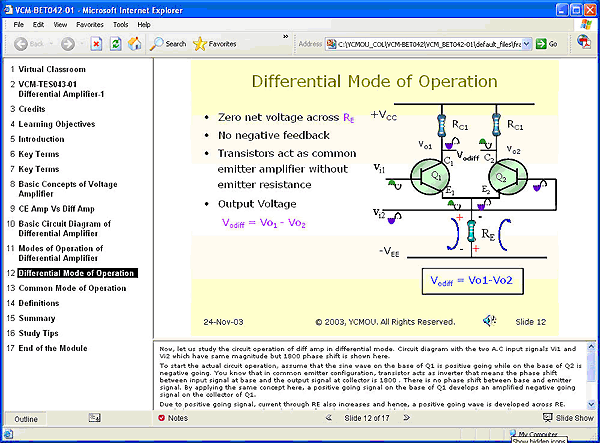
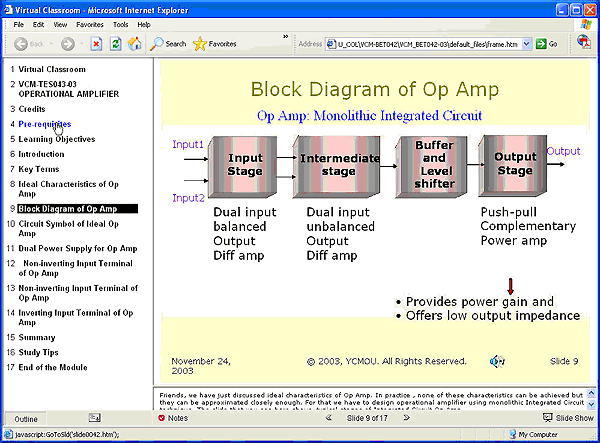
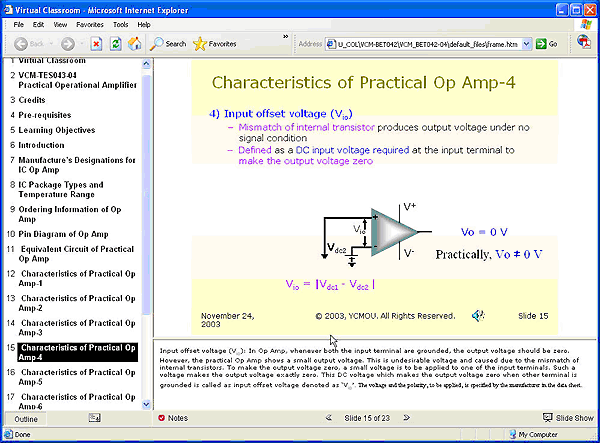

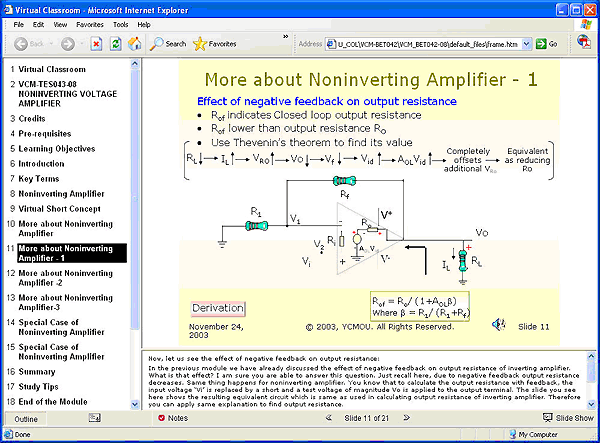
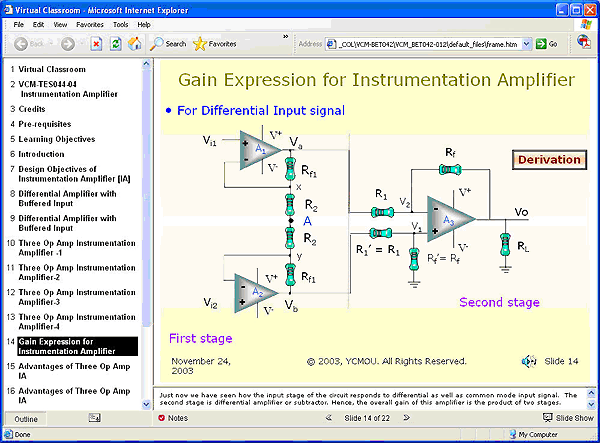
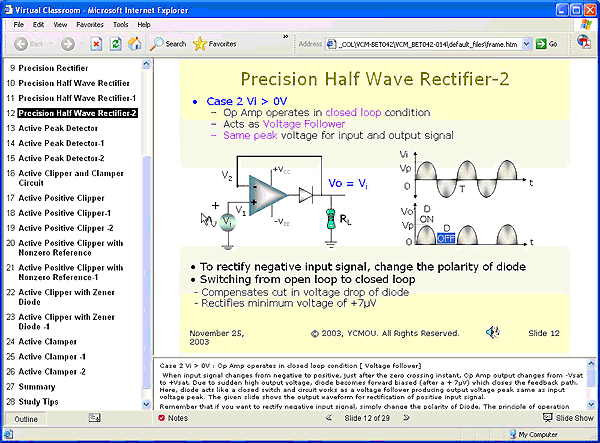
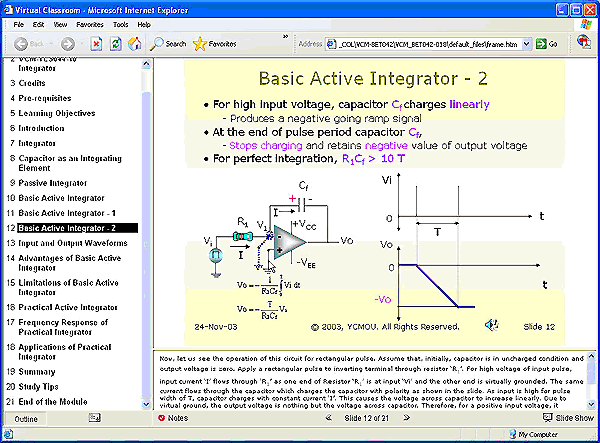
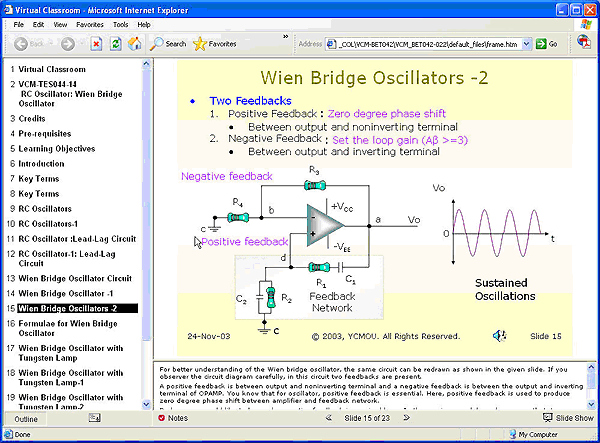
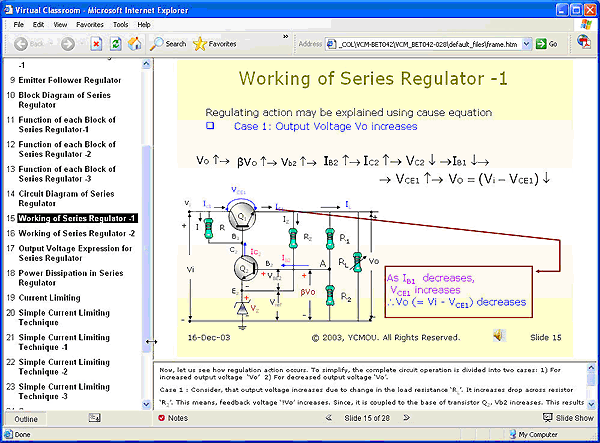
Figure 2 – 10-Sample Screens
Summary
Here, the aim was to develop and implement interactive multimedia tools for BET042 course which resembles the interaction between an excellent tutor and a student. The developed modules should serve as good learning tool to complement classroom and laboratory instruction which should enhance learning opportunities for students within the total context of their studies. All students should master the material they study. Everyone should learn to the highest level, even though the times of learning may differ from student to student
Student’s feedback shows a significant positive impact on their studies, understanding the dynamic behavior of the electronics circuits. Use of VCMs has brought paradigm shift in the student community from teacher centric to learner centric. Moreover, VCMs enable anywhere anytime self-learning. At present, however, the efficacy of VCMs has been quite clearly demonstrated and surely deserves further, in depth, investigation.
References:
Killedar Manoj (2002), “Development Manual for Virtual Classroom Modules”, Unpublished, YCMOU, Nashik.
Killedar Manoj (2001), “Distance Education Through Internet Based ELearning”, Indian Journal of Open Learning, 10(1), pp 68-69.
Baehr, Cj, “Interactivity in distance learning: Connecting students, instructors and content”, In C. Olgren, (Ed.), Proceedings of the 11th Annual Conference on Distance, 1995. Teaching and Learning, 11, 11-16. Madison, WI: University of Wisconsin, Madison.
Karuppan, Corinne M. and Muthu (1999,Sept). “Empirically based guidelines for developing teaching materials on the Web.” Business Communication Quarterly 62, 37-46.
Jegede, O.J (1992), “Constructivist Epistemology and its Implications for Contemporary Research in Distance Education”, In T. Evans & P. Juler (Eds.) Research in Distance Education Vol. 2, Geelong: Deakin University Press.
Bates, A. W. (Tony). (2000). Managing technological change: Strategies for college and university leaders. San Francisco, CA: Jossey-Bass
Jegede, O. J, “Contextualizing research methodologies in distance and open learning in Asia”, Paper presented at the 12th Annual conference of the Asia Association of Open Universities, Hong Kong, 4-6 November 1998.
Bork, Alfred, "Distance Learning and Interaction: Toward a Virtual Learning Institute", Journal of Science Education and Technology, Volume 4, 1995.
Oakley II, B., "Implementation of A Virtual Classroom in an Introductory Circuit Analysis Course," Proceedings, 1995 ASEE Annual Conference, ASEE, v. 1, 1995, pp. 187-191.
Wood III, W. H. and A. M. Agogino (1996, Nov), "Engineering Courseware Content and Delivery: the NEEDS Infrastructure for Distance Independent Education," Journal of the American Society for Information Science, 47 (11), pp. 863-869.
Web Sites on Internet:
http://www.ysmou.com/: YCM Open University, India
http://www.microsoft.com/: Microsoft Corporation, USA
http://www.ouhk.edu.hk/: The Open University, Hong Kong
http://www.athena.edu/: Virtual Online University
About the Author
Chetana H Kamlaskar is a Lecturer at the School of Science and Technology, Yashwantrao Chavan Maharashtra Open University at Dyangangotri, Near Gangapur Dam, Gangapur, Nashik 422 222, MS, India.